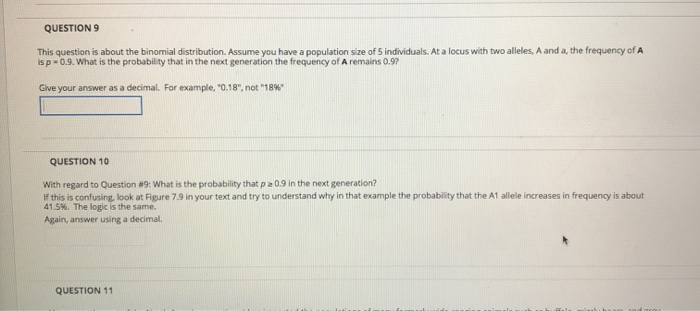This question is about the binomial distribution. Assume you have a population size of 5 individuals. At a locus with two alleles, A and a, the frequency of A is p-0.9. What is the probability that in the next generation the frequency of A remains 0.9? Give your answer as a decimal. For example, "0.18", not "18" QUESTION 10 With regard to Question #9: What is the probability that p a 0.9 in the next generation? If this is confusing, look at Figure 7.9 in your text and try to understand why in that example the probability that the A1 allele increases in frequency is about 41.5%. The logic is the same. Again, answer using a decimal.
This question is about the binomial distribution. Assume you have a population size of 5 individuals. At a locus with two alleles, A and a, the frequency of A is p-0.9. What is the probability that in the next generation the frequency of A remains 0.9? Give your answer as a decimal. For example, "0.18", not "18" QUESTION 10 With regard to Question #9: What is the probability that p a 0.9 in the next generation? If this is confusing, look at Figure 7.9 in your text and try to understand why in that example the probability that the A1 allele increases in frequency is about 41.5%. The logic is the same. Again, answer using a decimal.
Human Anatomy & Physiology (11th Edition)
11th Edition
ISBN:9780134580999
Author:Elaine N. Marieb, Katja N. Hoehn
Publisher:Elaine N. Marieb, Katja N. Hoehn
Chapter1: The Human Body: An Orientation
Section: Chapter Questions
Problem 1RQ: The correct sequence of levels forming the structural hierarchy is A. (a) organ, organ system,...
Related questions
Question
Plz solve both question
Don't use chat gpt
Will definitely upvote

Transcribed Image Text:QUESTION 9
This question is about the binomial distribution. Assume you have a population size of 5 individuals. At a locus with two alleles, A and a, the frequency of A
is p=0.9. What is the probability that in the next generation the frequency of A remains 0.9?
Give your answer as a decimal. For example, "0.18", not "18%"
QUESTION 10
With regard to Question #9: What is the probability that p a 0.9 in the next generation?
If this is confusing, look at Figure 7.9 in your text and try to understand why in that example the probability that the A1 allele increases in frequency is about
41.5%. The logic is the same.
Again, answer using a decimal.
QUESTION 11
Expert Solution
This question has been solved!
Explore an expertly crafted, step-by-step solution for a thorough understanding of key concepts.
This is a popular solution!
Trending now
This is a popular solution!
Step by step
Solved in 3 steps

Knowledge Booster
Learn more about
Need a deep-dive on the concept behind this application? Look no further. Learn more about this topic, biology and related others by exploring similar questions and additional content below.Recommended textbooks for you

Human Anatomy & Physiology (11th Edition)
Biology
ISBN:
9780134580999
Author:
Elaine N. Marieb, Katja N. Hoehn
Publisher:
PEARSON

Biology 2e
Biology
ISBN:
9781947172517
Author:
Matthew Douglas, Jung Choi, Mary Ann Clark
Publisher:
OpenStax

Anatomy & Physiology
Biology
ISBN:
9781259398629
Author:
McKinley, Michael P., O'loughlin, Valerie Dean, Bidle, Theresa Stouter
Publisher:
Mcgraw Hill Education,

Human Anatomy & Physiology (11th Edition)
Biology
ISBN:
9780134580999
Author:
Elaine N. Marieb, Katja N. Hoehn
Publisher:
PEARSON

Biology 2e
Biology
ISBN:
9781947172517
Author:
Matthew Douglas, Jung Choi, Mary Ann Clark
Publisher:
OpenStax

Anatomy & Physiology
Biology
ISBN:
9781259398629
Author:
McKinley, Michael P., O'loughlin, Valerie Dean, Bidle, Theresa Stouter
Publisher:
Mcgraw Hill Education,

Molecular Biology of the Cell (Sixth Edition)
Biology
ISBN:
9780815344322
Author:
Bruce Alberts, Alexander D. Johnson, Julian Lewis, David Morgan, Martin Raff, Keith Roberts, Peter Walter
Publisher:
W. W. Norton & Company

Laboratory Manual For Human Anatomy & Physiology
Biology
ISBN:
9781260159363
Author:
Martin, Terry R., Prentice-craver, Cynthia
Publisher:
McGraw-Hill Publishing Co.

Inquiry Into Life (16th Edition)
Biology
ISBN:
9781260231700
Author:
Sylvia S. Mader, Michael Windelspecht
Publisher:
McGraw Hill Education